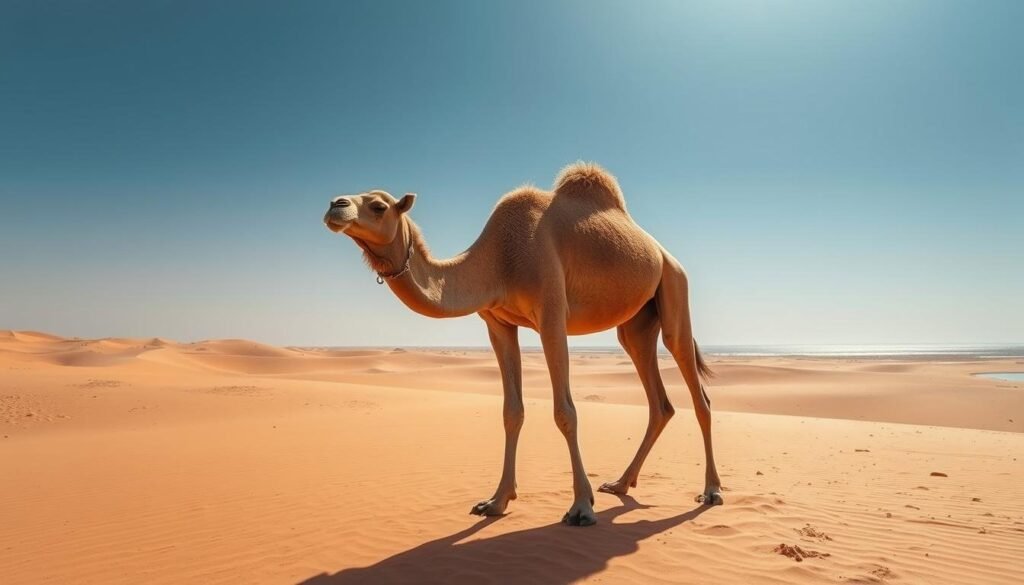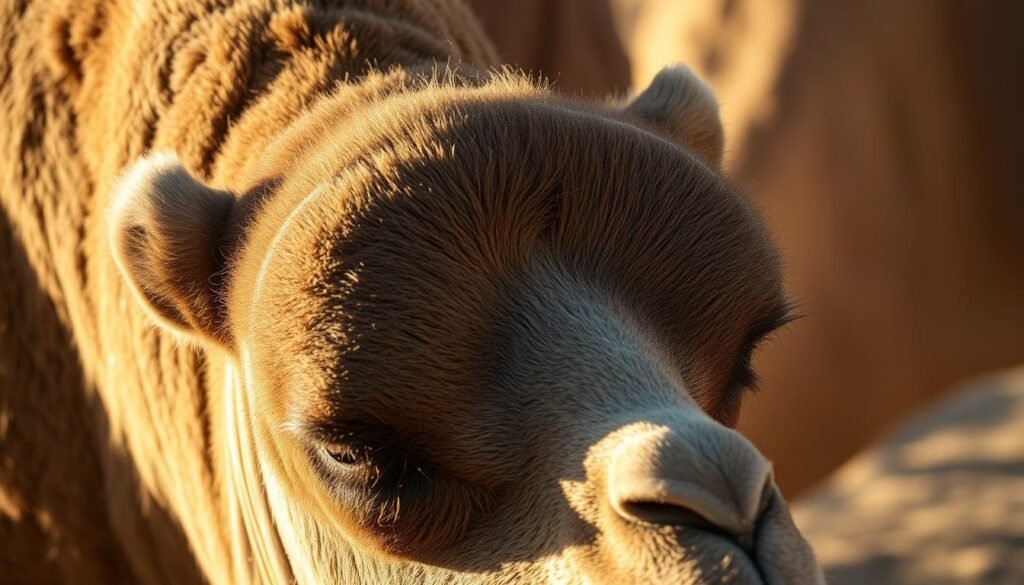Why Do Camels Store Fat in Their Humps? Have you ever looked at a camel’s humps and wondered why they’re there? These humps are not just a cool feature. They are key to camels surviving in the desert.
Camels are famous for going without water for a long time. Their humps help them do this by storing fat. This stored energy lets them handle the desert’s heat.
Learning about camel humps shows us how animals adapt to their environments. It’s a fascinating look into the biology of these amazing creatures.
Contents
- 1 The Biology of Camel Humps
- 2 Why Do Camels Store Fat in Their Humps?
- 3 Survival Benefits of Hump-Based Fat Storage
- 4 How Camels Use Their Hump Fat in Extreme Conditions
- 5 Conclusion: Why Do Camels Store Fat in Their Humps?
- 6 FAQ
- 6.1 What is the primary function of a camel’s hump?
- 6.2 How do camels metabolize the fat stored in their humps?
- 6.3 What role does natural selection play in the development of camel humps?
- 6.4 How does the hump aid in insulation and heat dissipation?
- 6.5 What happens to a camel’s hump during periods of food scarcity?
- 6.6 How do camels recover their hump fat after a period of scarcity?
- 6.7 Can camels survive without water by using their hump fat alone?
- 6.8 Are camel humps unique to certain species of camels?
The Biology of Camel Humps
The biology of camel humps is complex. It involves a system for storing and using fat. You might be curious about how these humps help camels survive in the desert.
The hump on a camel’s back is mostly fat. This unique fat storage lets camels go without water or food for a long time. The hump is more than just fat; it’s a key part of the camel’s body.
Camel humps are filled with fatty tissue, which gets blood from a network of vessels. When a camel doesn’t eat or drink, it uses the fat in the hump to survive. This is how camels can live in the desert’s harsh conditions.
Learning about camel humps shows how amazing camels are at living in dry places. The hump’s role in using fat is key. It lets camels use energy when they need it most.
Why Do Camels Store Fat in Their Humps?
Camels have a special way of storing fat in their humps. This is key for surviving in the desert. [Why Do Camels Store Fat in Their Humps?]
For thousands of years, camels have roamed deserts. Their humps help them go without water or food for a long time.

Camels have been adapting to desert life for millions of years. They didn’t always live in deserts. They moved there over time.
- Initial migration: Camels started moving to deserts around 4 million years ago.
- Adaptation phase: Over a few million years, they changed a lot to live in the desert.
- Established adaptation: By 2 million years ago, they had their hump and other desert survival traits.
Natural Selection Factors
Several factors helped camels develop hump-based fat storage. These include surviving droughts and food shortages.
| Selection Factor | Description | Impact on Camels |
|---|---|---|
| Water Scarcity | Lack of water in desert environments | Camels can survive longer without water due to fat storage in their humps. |
| Food Scarcity | Periodic lack of food in desert habitats | Fat stored in humps provides energy during periods of famine. |
| Extreme Temperatures | High temperatures during the day, low at night | Camels’ humps help regulate energy use during extreme temperature fluctuations. |
Understanding these factors helps us see the camel’s hump’s complex history. [Why Do Camels Store Fat in Their Humps?]
Survival Benefits of Hump-Based Fat Storage
In the desert, the camel’s hump is key for energy and protection. You might ask how this helps them survive. The hump is more than fat; it’s a smart way for camels to handle extreme heat and food and water shortages.
Insulation Distribution Benefits
The fat in the camel’s hump helps keep their body temperature steady. This fat in one spot lets the rest of their body cool down better. It’s a clever way for camels to stay cool in the desert’s heat.
Heat Dissipation Mechanisms
Camels have special ways to cool down, and the hump helps. The fat in the hump lets the rest of their body cool off better. This is key for keeping their body temperature stable in harsh conditions.
| Physiological Adaptation | Camels | Other Desert Animals |
|---|---|---|
| Fat Storage | Concentrated in hump | Distributed throughout the body |
| Insulation | Localized, allowing for better heat dissipation | Generalized, potentially leading to heat retention |
| Water Conservation | Efficient, aided by hump fat metabolism | Varies by species, often less efficient |
Understanding the camel’s hump survival benefits shows how amazing these animals are. Their fat storage, insulation, and cooling systems are incredible. The camel’s hump is a top example of how animals adapt to survive in tough places.
How Camels Use Their Hump Fat in Extreme Conditions
The hump fat of a camel is more than just energy storage. It’s a vital lifeline in harsh desert environments. When camels face tough desert conditions, their hump fat is crucial for survival.
Camels use their hump fat to keep their body functions going. This fat is broken down into energy. This energy helps the camel survive for long without water or food.
When food is scarce, a camel’s hump changes. The hump softens and becomes less erect as the fat is used. This change shows how much the camel relies on its hump fat to live.
- The hump’s size reduces as fat is consumed.
- The hump becomes less firm to the touch.
- In extreme cases, the hump may flop to one side.
Recovery Process After Feeding
When camels eat again, their humps start to refill. This process takes time. You’ll see:
- The hump starts to get its original size and firmness back.
- The camel’s health and energy improve.
- The hump returns to its normal upright position.
Camels’ ability to store and use fat makes them very strong in extreme conditions. Their hump fat shows their amazing adaptability and survival skills in harsh deserts.
Conclusion: Why Do Camels Store Fat in Their Humps?
Camel humps are more than a unique feature; they are a key survival tool. These humps store fat, helping camels survive in harsh desert conditions. Here, food and water are scarce.
The biology of camel humps is truly fascinating. It lets camels go without food for a long time. They use the fat in their humps for energy and sustenance.
This adaptation is vital in the desert. Temperatures are extreme, and resources are limited. The camel’s ability to survive shows its remarkable physiology.
In conclusion, the camel’s hump is a perfect survival mechanism. It lets these animals thrive in very tough environments. Studying camel humps gives us insights into how anatomy, physiology, and environment interact.
See Also: Why Do Skunks Stomp Their Feet When Threatened?
FAQ
What is the primary function of a camel’s hump?
A camel’s hump stores fat. This fat is used as energy when food is scarce. [Why Do Camels Store Fat in Their Humps?]
How do camels metabolize the fat stored in their humps?
Camels break down the fat in their humps into energy. This energy helps them survive when food and water are scarce.
What role does natural selection play in the development of camel humps?
Natural selection helped camels develop humps. This gave them an edge in desert environments. It allowed them to survive where others might not.
How does the hump aid in insulation and heat dissipation?
The hump stores fat, which helps keep the camel cool. It also allows the camel to release heat through its circulatory system.
What happens to a camel’s hump during periods of food scarcity?
When food is scarce, a camel’s hump shrinks. The stored fat is used for energy. The hump becomes softer and less firm. [Why Do Camels Store Fat in Their Humps?]
How do camels recover their hump fat after a period of scarcity?
Camels regain their hump fat by eating nutrient-rich foods. This helps them restore their fat stores and hump firmness.
Can camels survive without water by using their hump fat alone?
Camels can go without water for a while by using hump fat. But, they still need water to function properly. Hump fat is not a water substitute.
Are camel humps unique to certain species of camels?
Yes, humps are unique to dromedary and Bactrian camels. Not all camel species have humps. [Why Do Camels Store Fat in Their Humps?]

Zyair Larson, based in Denver, Colorado, has over 12 years of experience studying animal behavior. He has worked with the World Wildlife Fund (WWF) and National Geographic, researching wildlife and sharing insights on animal habits globally.

